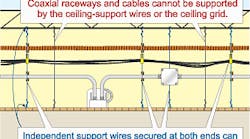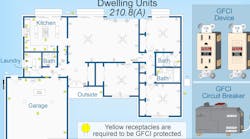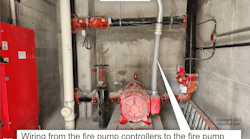Article 820 covers the distribution of television and radio signals via cable. This is in contrast to Art. 810, which covers the distribution of television and radio signals via antenna.
Any installation involving coaxial cables that connect antennas to any of the following must comply with Art. 820:
-
Television receiving equipment [810.3].
-
Radio receiving equipment [810.3].
-
Community television systems (CATV) [810.4].
In these cable applications, CATV coaxial cable delivers low-energy power from a power-limited power supply to equipment associated with the radio frequency distribution system. This occurs at a maximum of 60V from a power supply that has energy-limiting characteristics. Examples of such supplies include boosters, amplifiers, and some splitters [820.15].
Cable installation basics. Install equipment and cabling in a neat and workmanlike manner [820.24]. You can find the industry practices described in ANSI/NECA/BICSI 568, Standard for Installing Commercial Building Telecommunications Cabling.
Exposed cables must be supported by the structural components of the building to prevent cable damage due to normal building use. Secure cables with straps, staples, hangers, or similar fittings designed and installed so as not to damage the cable.
Cables run parallel to framing members or furring strips must be protected where they are likely to be penetrated by nails or screws. To provide this protection, you have two options:
-
Install the cables at least 1¼ inches from the nearest edge of the framing member or furring strips.
-
Protect the cable with a 1/16-inch-thick steel plate [300.4(D)].
You must securely fasten raceways that contain coaxial cables in place. Don't use ceiling-support wires or the ceiling grid to support raceways or cables (Fig. 1). You can, however, support raceways and cables with independent support wires attached to the suspended ceiling per 300.11(A).
Remove the accessible portion of cable that isn't terminated at equipment (and not identified for future use with a tag). This rule doesn't require the removal of concealed cables that are abandoned in place. A cable in a raceway is concealed (per the Art. 100 definition). If you run cables through fire-resistant-rated walls, partitions, floors, or ceilings, make sure you firestop them [820.3(A)].
Overhead cables. Don't attach coaxial cables to a mast that encloses or supports power and lighting conductors [820.44(C)]. Separate the coaxial cable at least 4 inches from electric light and power conductors. Where practicable, maintain a separation of at least 6 feet between coaxial cables and lightning protection conductors [820.44(F)(3)].
Underground circuits entering buildings. Underground coaxial cables in a pedestal or handhole enclosure must be in a section permanently separated from exposed electric light, power, or Class 1 circuit conductors by a suitable barrier [820.47].
Run direct-buried coaxial cable at least 12 inches from underground light, power, or Class 1 circuit conductors (Fig. 2). You don't need to separate underground coaxial cables from service conductors, if the service conductors or coaxial cables are installed in a raceway or cable armor. You don't need to separate underground coaxial cables from feeder or branch-circuit power conductors, if the power conductors are installed in a raceway or in metal-sheathed, metal-clad, UF, or USE cables, or the coaxial cables have metal cable armor or are installed in a raceway.
Grounding methods. When grounding the shield of the coaxial cable, use an insulated grounding conductor made of copper or other corrosion-resistant conductive material [820.100]. The conductor can't be smaller than 14 AWG. It doesn't have to be larger than 6 AWG, but it must have a current-carrying capacity equal to that of the outer conductor. Make it as short as practicable, and run it as straight as practicable.
In one- and two-family dwellings, limit the grounding conductor length to 20 feet unless such a limitation just isn't practicable. If you need more than a 20-foot length, then you also have to install a separate ground rod that's at least 8 feet long [820.100(A)(4) Ex.]. Bond the rod to the power grounding electrode system with a minimum 6 AWG conductor [820.100(D)] (Fig. 3). If you don't bond the rod to the main system, you create a difference of potential and a flashover hazard.
If you run the grounding conductor in a metal raceway, bond each end to the raceway. This, like bonding that electrode, eliminates differences of potential.
The grounding conductor must terminate to the nearest accessible point or item from the list below:
-
Grounding electrode system [250.50].
-
Interior metal water piping system, within 5 feet from its point of entrance [250.52(A)(1)].
-
Accessible service bonding means [250.94].
-
Metallic service raceway.
-
Service equipment enclosure.
-
Grounding electrode conductor or associated metal enclosure.
-
The grounding electrode conductor or grounding electrode of a building disconnecting means that is grounded per 250.32.
Indoor cables. If you run coaxial cables in Chapter 3 raceway, comply with Chapter 3 installation requirements for the wiring method. If you use nonmetallic raceways listed for coaxial cables, comply with 820.182. Never use a raceway as a support for cables. Cables can go in a raceway; they can't be hung from one.
To prevent a fire or shock hazard that could occur from a short between higher-voltage circuits and coaxial cable, keep these conductors and coaxial cable separated. You'll find specific rules and exceptions in 820.133.
Don't install coaxial cables in ducts or plenums [820.3(B)], unless the cables run to equipment used for direct action upon (or sensing of) the contained air. If you do run coaxial cables into ducts or plenums, install them in electrical metallic tubing, intermediate metal conduit, or rigid metal conduit [300.22(B)]. Plenum rated coaxial can never be run in a duct or plenum without one of these metallic raceways.
You can install plenum-rated Type CATVP cables [820.179(A)] above a suspended ceiling or below a raised floor that is used for environmental air [300.22(C)]. Nonplenum-rated Type CATV cables can be installed in these spaces if installed in a metallic raceway type listed in 300.22(C)(1).
If coaxial cables run vertically and penetrate more than one floor, they must be Type CATVR [820.179(B)] or Type CATVP [820.179(A)], unless you run them in metal raceway. You can install Type CATVP, CATVR, and CATV coaxial cables in a cable tray [820.154(C)].
Listings. Are you installing cables in areas that move or transport environmental air? Pay close attention to installation requirements. If these seem confusing, just remember that the NEC is trying to reduce the hazards that arise from the burning of conductor insulation, the jackets of cables, and nonmetallic raceways.
Because listed plenum-rated cables have adequate fire-resistant and low smoke-producing characteristics, you can install them exposed in environmental air spaces. You cannot install exposed cable in ducts or plenums for any reason.
Article 820 provides four designations for listed coaxial cable types [820/179]:
-
CATV. The letters stand for “Community Antenna Television,” and this is your basic, general-purpose cable.
-
CATVP. The P is for plenum.
-
CATVR. The R is for riser.
-
CATVX. This is a limited-use cable for dwellings and in raceway.
Article 820 provides three designations for listed coaxial raceway types [820.182]:
-
General-purpose coaxial raceway. These can contain CATV, CATVX, CATVR, or CATVP cables.
-
Plenum coaxial raceway. These are listed for use in other spaces used for environmental air spaces and must contain only Type CATVP cable [820.179(A)]. Plenum coaxial raceways cannot be installed in ducts or plenums [300.22(B)]
-
Riser coaxial raceway. These are listed as being suitable to be run vertically through more than one floor. If they run vertically and penetrate more than one floor, they can contain only CATVR and CATVP cables [820.179(B)].
Article 820 can seem a bit abstract, especially if you have been working in Chapters 1 through 4 and are just now entering the world of communications installations. But when you examine Art. 820 carefully, you can see that it doesn't tell you anything you don't already know about installation practices. For example, you've got to bond metallic parts to prevent flashover — that's an Art. 250 fundamental. You also need to use the correct cable and raceway, which is something Chapter 3 veterans already know how to do.
Still, Art. 820 does contain some specifics that you should review to make sure you do the job right. If you remember to use the same general concepts you've already been applying in traditional electrical work, these specifics will easily make sense to you.
Sidebar: 820 Tips
- Determine the “point of entrance.”
- Ground the incoming cable as close as practicable to the point of entrance.
- If you run cables above a suspended ceiling, route and support them to allow access via ceiling panel removal.
- If you use a separate grounding electrode, bond it to the power grounding system.
- Use the correct cable type and raceway for the application — general, plenum, or riser.







